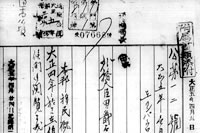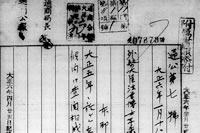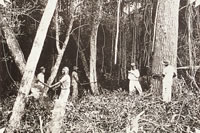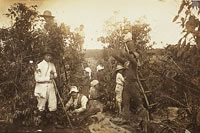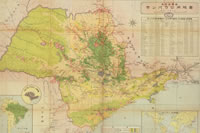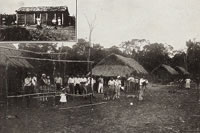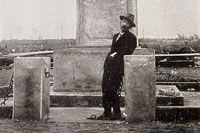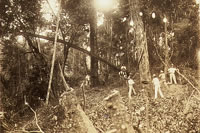From colonos to independent farmers
Got to be able to earn a secure and reliable living
Three or four years after assigned to coffee plantations, emigrants' living began to stabilize. For example, in the Sobrado plantation, to which emigrants of the first set on board the ship Kasato-maru, had been assigned, they earned on average 910 reis per day equivalent to 54 sen (as mentioned before, in 1902 a rickshaw man earned 40-50 sen per day), but afterwards grew accustomed to the work and earned 60 sen to 1 yen 20 sen per day in November of the same year.
Even if income from working in the coffee plantation was low, they were allowed to intercrop (rice, corn, beans, sugar cane, vegetables) and raise livestock in an space between ridges in coffee trees and in land outside of coffee plantation on Saturday afternoons and Sundays to earn extra income by selling those crops and the livestock except ones for self-consumption.
Three years later, in July 1911, they thus earned annual income of 1,200 mil reis (840 yen) sufficient to send average yearly 350-420 yen to their families in Japan. Other plantations were also under the same situation.
Becoming a self-employed farmer
Some emigrants left coffee plantations with money they had saved while working in coffee plantations or even if they had not saved a lot of money, after their contracts had expired, and started self-employed farming by sharing crops produced on the land with a landowner (called "sharecropping") or renting or purchasing land in installments. (All the emigrants intended to earn money and return to Japan, and some emigrants would not purchase land because they considered that purchase of land would result in loss of money)
It were reported (according to the report from the Ministry by Charge d'Affaires ad Interim, Toshiro Fujita to the Ministry of Foreign Affairs in July 1911) that in 1911, three years after Japanese emigrants were sent to coffee plantations, a family of three rented 10 ha of forestland in the Itu region and begun self-employed farming and profited from it. It was said that in 1911, Japanese families (three families from Nagasaki prefecture settled in 1910 according to the report from Consul General in São Paulo City, Sadao Matsumura in March 1915) settled as self-employed farmers in the Monson colony that was constructed in 1909 (between the Agudos station before Bauru on the Sorocabana line and the Cerqueira César station on the center branch line of the same line).
-
 Report on Japanese emigrants’ situation in 1915
Report on Japanese emigrants’ situation in 1915 -
 Japanese migrant conditions in 1916
Japanese migrant conditions in 1916 -
Articles in newspapers / magazines
-
 Clearing a primeval forest in this way before the project
Clearing a primeval forest in this way before the project -
 Coffee harvesting scene
Coffee harvesting scene
Formation of Japanese settlements
Afterwards, Japanese emigrants started to farm independently in several regions, and the number of those who farmed independently reached 400 families only within the State of São Paulo by late 1915 (according to the report from Consul General Matsumura in January 1916). Japanese emigrants left coffee plantations in groups and settle in the same land and started to reclaim it since they had neither yet mastered the language nor got familiar with customs and traditions in Brazilian society. Japanese emigrants settled in the areas one after another where other Japanese emigrants had already settled, and consequently Japanese settlements (colonies) were formed.
A Japanese society was founded in each Japanese settlement to foster friendship and mutual aid. Japanese societies, first of all, established Japanese language schools so that emigrants’ children would not face with problems with language when they returned. The major Japanese emigrant settlements (colonies) formed during the 1910s were the following:
São Paulo Outskirts
Juqueri district
It is said the first Japanese immigrant arrived in Juqueri (the former name of Francoda Rocha), located in the outskirts of São Paulo City, approximately 33 km north of the city, in 1911 (Takezo Mamizuka of the 2nd set of emigrants on board the ship Ryojun-maru) and began growing potatoes and by October 1913, nine families, including Choju Akimura, had purchased land and moved to Jucqueri. Afterwards the Juqueri Agricultural Cooperative was established in the settlement, and this cooperative developed into a huge organization, the Nanpaku Nogyo Kyodo Kumiai Chuokai (South Brazil Central Union of Agricultural Cooperatives) in the postwar period.
Cotia Village
In 1913, young single emigrants who had been working as carpenters in the city of São Paulo and emigrant families who had left the Guatapara plantation, rented land owned by a church in Moinho Velho on the outskirts of São Paulo City (27km southwest of the city) and began farming there. It was not long before a Japanese immigrant settlement (called "Cotia Village") was formed. Although land used to be farmed extensively, without plowing burned fields and without using fertilizers, in this area, those Japanese immigrants began to plow land as in Japan, and to use purchased fertilizers (fertilizers made from livestock entrails at first and chemical fertilizers from 1923 onwards). These agricultural methods enabled them to achieve great economic success with the shipment of large quantities of potatoes to São Paulo City. Afterwards, in this settlement as well an agricultural cooperative, the Cotia Agricultural Cooperative, was formed, which developed into the largest agricultural cooperative in South America during and after the war.
Along the Noroeste line
Hirano Colony
Hirano Unpei was one of the five interpreters who accompanied the emigrants on board the ship Kasato-maru to the plantations, dispatched to the Guatapara plantation and appointed as an assistant director of the plantation. He recruited settlers from among Japanese families at the Guatapara plantation and other plantations. He managed to recruit 200 families and purchased 1,620 acres (3,920ha) of primeval forest land (the Hirano Colony) along the Dourado riverside 13km northeast of Presidente Penna station (the former name of Cafelândia station) which was located 125km from Bauru station on the Noroeste line. Their advance party entered the forest in August 1915, and by December of the same year, 82 families had settled and begun cultivating rice. But in November cases of malaria began to appear and by February of the next year, almost all of the settlers had been bedridden. One report says that nearly 80 persons died from the disease, and which was the most casualties in the history of Japanese emigration to Brazil. The location for this colony was chosen particularly because it was a lowland marsh conducive to rice cultivation; Japanese immigrants, however, were not aware of the dangers of malaria in such a lowland marsh at that time.
The plight of settlers in the Hirano colony continued. The colony was infested by a massive swarm of locusts in 1917 which ate all of the crops, and then faced a severe drought in 1918. In February 1919, Hirano Unpei died suddenly (at the age of 34). The settlers had to overcome all of these hardships and devote themselves to the development of the colony, and eventually succeeded in cultivating coffee and cotton.
First and Second Uetsuka colonies
In 1918, Uetsuka Shuhei, an overseas agent of the Kokoku Shokumin Kaisha (Kokoku Colonization Company) in Brazil, purchased 1,400 acres (3,388ha) of land in Itacolomy a little more than 4km from Heitor Legru station (the former name of Promissao station) , northwest of Lins and established the First Uetsuka Colony. It is said that a number of young people who admired Uetsuka settled in this colony. In 1922, Uetsuka established the Second Uetsuka Colony west of Lins.
Birigui Colony
In 1913, the Birigui colony was constructed in 50,000 acres (12,000ha) of land that the São Paulo Companhia de Terras, Extrativismo e Colonizacao (Land, Extraction and Colonization Company) reclaimed, around Birigui station located 260 km from Bauru on the Noroeste line. A Japanese immigrant settled here in 1915 for the first time, and a Japanese young man, Hachiro Miyazaki was employed as an agent of the Japanese section of the company in 1916. He helped Japanese immigrants to settle the colony and the number of Japanese families reached 296 in 1923.
Baibem Colony and Brejao Colony
Hoshina Ken'ichiro who was known for the publisher of the "Shukan Nanbei" (The South America Weekly), the first Japanese-language newspaper in Brazil, established the Baibem Colony in 1917 and the Brejao Colony in 1918, both of which was located along the Sorocabana Railway line. He placed advertisements in his newspaper to sell land in the colonies. Many settlers died in the reclamation period of the Brejao Colony due to endemic diseases and tuberculosis caused by, malnutrition and overwork.
Outside the State of São Paulo
Rice cultivation in Triangle Mineiro
Japanese emigrants who left coffee plantations in the State of São Paulo settled on the right bank area of the Rio Grande River known as the Triangle Mineiro in the west of the State of Minas Gerais, bordered by the State of São Paulo to the south, and began cultivating rice. It is said that in 1919 the number of Japanese families in the area reached 410 ones, but that the Japanese settlers dispersed due to the economic depression and soil fertility decline in rice paddies after World War I.
Immigrants from Okinawa prefecture became concentrated in Campo Grande
From the end of the Meiji Era through the Taisho Era, the Japanese emigrants who had come up the Rio de la Plata through Peru, Bolivia and Argentina and worked on the construction of the Noroeste railway, settled for the first time in the city of Campo Grande in the State of Mato Grosso bordered to the west of the State of São Paulo. Afterwards immigrants from Okinawa prefecture became concentrated in the city.
São Paulo City
Japanese clerks at the Fujisaki Shokai (Fujisaki Trade Company), toy paddlers and hotel housemen lived in São Paulo City before the first set of emigrants arrived. Contracted emigrants on board the ship Kasato-maru included carpenters and other craftsmen. Some of those contracted emigrants and the free emigrants settled in the city right after they arrived in Brazil. Some of the emigrants who ran away from plantations also settled there as domestic workers, factory workers and carpenters..
In the first half of the 1910s decade, Japanese immigrants began to settle in Conde de Sarzedas (abbreviated to "Rua Conde" or "Conde Street") and founded the Taisho Elementary Japanese School in 1914.
-
Books
Situations before and after the beginning of settlement in the Hirano Colony
-
 Temporary immigrant houses at the begining of settlement (in the Promissão Colony)
Temporary immigrant houses at the begining of settlement (in the Promissão Colony) -
 Shuhei Uetsuka standing in front of the monument commemorating ten years of reclamation
Shuhei Uetsuka standing in front of the monument commemorating ten years of reclamation -
 Migrants begin to live freely at last
Migrants begin to live freely at last -
Articles in newspapers / magazines

